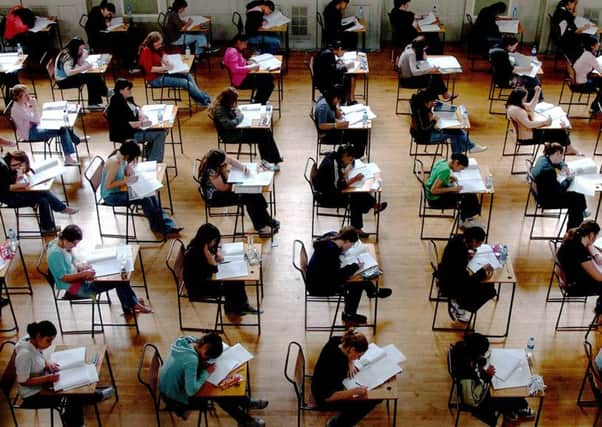State of the nation: A snapshot of Scotland


A snapshot of Scottish society was revealed with the publication of the Scottish Government’s annual household survey.
Based on interviews with 10,678 households conducted last year, the document found that just under half (48 per cent) of adults are married and less than one per cent are living in same-sex civil partnerships. The vast majority of adults (96.4 per cent) are of white ethnic origin with “white, Scottish” being the predominant ethnic group (79.7 per cent).
Advertisement
Hide AdAdvertisement
Hide AdAdults of Asian ethnicity represented the largest minority ethnic group (2.2 per cent).
The survey found an upward trend in the proportion of adults reporting not having a religion, from 40 per cent in 2009 to 46 per cent in 2013.
There has also been a corresponding decrease in the proportion reporting “Church of Scotland”, from 34 per cent to 28 per cent.
SPORT/CULTURE
Seventy-eight per cent of adults had taken part in physical activity in the last four weeks when they were survey in 2013, an increase from 74 per cent in 2012.
Walking for 30 minutes was the most prevalent activity, with around two thirds of adults (65 per cent) saying they took this form of exercise compared with 59 per cent in 2012.
Sports participation was higher for men than women, with 81 per cent of men and 75 per cent of women taking part in a range of activities. Men chose to take part in football, went to the gym and played golf while women liked swimming, aerobics and dancing.
More than one in ten (91 per cent) adults took part in a cultural activity in 2013 – a one per cent increase from the previous year.
Eighty per cent of adults had attended a cultural event or place in the last 12 months which is up from 78 per cent in 2012. The most popular form of cultural attendance was watching films at a cinema(56 per cent).
INTERNET USE
Advertisement
Hide AdAdvertisement
Hide AdThe internet has become a feature of Scottish home life with 78 per cent of households having an online connection at home. Online activity was less prevalent, however, in the 15 per cent most deprived households, where 64 per cent had internet access.
The survey identified the rising use of tablets/smart phones, which has increased from 25 per cent to 30 per cent when 2012 was compared with 2013. One fifth (20 per cent) of adults reported not using the internet at all, down from 22 per cent in 2012.
ECONOMIC ACTIVITY
Three per cent of households have no bank account. 24 per cent have no savings, 20 per cent have no qualifications.
Forty-nine per cent of working age adults in households earning over £40,000 had degree level or professional qualifications. A higher proportion of men (58 per cent) than women (49 per cent) were in work.
Six in ten households included at least one adult in paid employment. Half of the households in the 15 per cent most deprived areas had no adults in paid employment (52 per cent).
NEIGHBOURHOOD/HOUSING
The survey revealed that 280,000 (six per cent of) Scottish adults are on a housing waiting list.
Nearly half (48 per cent) of single parent households are in social housing and one third of households consist of a person living alone.
Ninety per cent said their neighbourhoods were very or fairly or good places to live. Over three quarters (78 per cent) were confident in the ability of the police to investigate incidents, while 66 per cent were confident in the ability of the police to prevent crime.
Advertisement
Hide AdAdvertisement
Hide AdThe private rented sector has grown from 5 per cent in 1999 to 13 per cent and the social rented sector has declined from 32 per cent in 1999 to 23 per cent. Owner occupation has dipped from 66 per cent in 2009 to 61 per cent in 2013.
Fifty-five per cent of households in the 15 per cent most deprived areas in Scotland were in the social rented sector compared with 17 per cent in the rest of Scotland.
HEALTH
Twenty-three per cent of adults were smokers in 2013. More men than women smoke (25 per cent and 22 per cent, respectively).
Adults in the 15 per cent most deprived areas of Scotland were more likely than those in the rest of Scotland to be current smokers (40 per cent and 20 per cent respectively).
Around one third of households in Scotland (34 per cent) contained at least one person with a long-standing illness, health problem or disability.
Three quarters of adults (74 per cent) reported that their own health is either “very good” or “good’” compared to seven per cent saying their health is either “bad” or “very bad”.
People living in the 15 per cent most deprived of areas in Scotland were more likely to say their health is “bad” or “very bad” compared to those living elsewhere (14 per cent).
TRANSPORT
Successive government campaigns appear to have failed to lessen the appeal of the car to Scots.
Advertisement
Hide AdAdvertisement
Hide AdCar drivers and passengers accounted for 64 per cent of journeys – 3 per cent more than in 2012.
Walking was down by a similar amount, to 23 per cent of trips, while 6 per cent of those who walk to work in 2012 had switched to driving.
Buses increased their share marginally, by less than half a point to 8.5 per cent, but cycling, trains and taxis were virtually unchanged at 1-2 per cent each.
A Transport Scotland spokesman said: “The Scottish Government aims to get more people making active travel choices for their everyday journeys, to improve health and the environment. However, behaviour change does not happen overnight.”